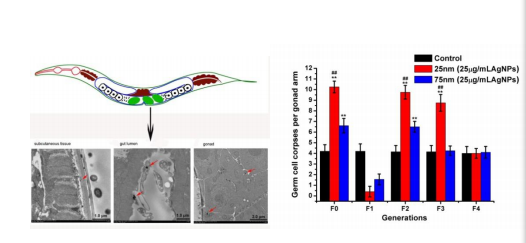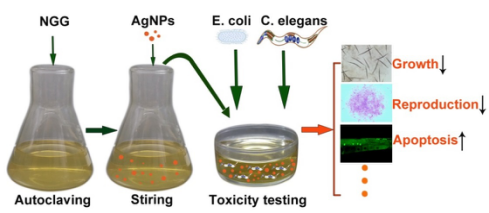Nanoparticles have been widely used in medicine and commercialized products for their antimicrobial property. In the meantime, owing to the large-scale production and application of AgNP-related products, nanoparticles (such as AgNPs) inevitably enter the environment. Previous studies demonstrates that AgNPs released to the environment are harmful to the ecosystem, however, the behavior and toxicity of AgNPs in ecoysystem call for further exploration.
Food chain transport is an important consideration to evaluate ecological toxicity of engineered nanomaterials. In consideration of the shortcoming of behave and toxicity of AgNPs in food chain, a study team led by Prof. WU Lijun in Hefei Institutes of Physical Science systematically evaluated the physiological behavior and toxicity of polyvinylpyrrolidone (PVP)-coated silver nanoparticles (AgNPs) using a food chain model from Escherichia coli (E. coli) to Caenorhabditis elegans (C. elegans). Their research was published in journal of Scientific Reports with title Insights into the Ecotoxicity of Silver Nanoparticles Transferred from Escherichia coli to Caenorhabditis elegans.
Through the study, they demonstrated that AgNPs accumulated in E. coli could be transferred to the C. Elegans, and the accumulated AgNPs caused serious toxicity which reached the higher trophic level (C. elegans). More importantly, the AgNPs that had accumulated in C. elegans could cause genetic damage across generations (Figure 1).
In addition, the biggest problem in the ecological toxicity evaluation of nanomaterials using C. elegans was the dispersion of nanomaterials in culture medium as the nanoparticles were not stable and uniformly dispersed in the medium. To solve this problem, a semi-fluid NGG method to assess toxicity of AgNPs using C. elegans was proposed (Figure 2).
Moreover, their results demonstrated that AgNPs homogeneously and stably dispersed in NGG compared to that in liquid KM. Furthermore, the toxicity of AgNPs obtained in the NGG test medium was much more sensitive than that in the standard NGM and KM in the end points of body length, fecundity, lifespan, population growth, germline cell apoptosis, reactive oxygen species, and mitochondrial membrane potential etc.
This study was sponsored by the National Basic Research Program of China (2014CB932002).

Figure 1. (Left) TEM images of intracellular localization of AgNPs in C. elegans fed AgNPs-treated E. coli included the subcutaneous tissue, gut lumen, and gonad. The red arrows indicate AgNPs. (Right) Germ cell death in parental C. elegans induced by two size AgNPs at 25 μg/mL through the food chain transferred to subsequent generations (F1-F3). (Image by LUO Xun)

Figure 2. NGG culture method for evaluating the toxicity of silver nanoparticles using C. elegans. (Image by LUO Xun)
Contact
WU Lijun
Institute of Technical Biology & Agriculture Engineering (http://english.itb.cas.cn/)
Hefei, Anhui 230031, China
Tel: 0551-65591062
E-mail: ljw@ipp.ac.cn
 Tel: +86-551-65591206
Tel: +86-551-65591206
 Fax: +86-551-65591270
Fax: +86-551-65591270
 Emai: zhous@hfcas.ac.cn
Emai: zhous@hfcas.ac.cn
 350 Shushanhu Road
350 Shushanhu Road